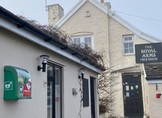Defibrillators

Defibrillators are located on the outside wall of Llangrove village hall and outside The Royal Arms.
Both are ready for use if needed in an emergency and unlocked. When opened a loud siren will be activated.
How to use the defibrillator:
First - call an ambulance to request help before using the defibrillator. Professional help can then be on its way while you try to keep the patient alive.
Ensure a safe working area away from water (a little rain or puddle up to 1" deep are allowable), inflammable chemicals and ensure that any oxygen tubes are removed from the patient who must not be on a metal surface.
Remove all clothing from the patient's chest including any medication patches, metal jewelry, nipple piercings and, in the event of an especially hairy chest, quickly shave the area where the chest pad will be placed. A disposable razor is included in the pack with the defibrillator machine.
If the patient has a pacemaker, which will be obvious beneath the skin on the chest wall, the pads should be placed at least 1" away from this.
Both colour-coded pads feature clear diagrams to indicate how they should be positioned on the patient with the yellow pad to the right side of the chest front and the red pad to the left side under the arm. The defibrillator will analyse the patient's heart rhythmn to determine whether shocking is advised and will give audible instructions while continuing to analyse and check the patient every 2 minutes.
If shocking is not advised:
Depending on the patient's heart rhythm, the defibrillator may state 'no shock advised' if the patient is not in a rhythm suited to shock treatment. In this case, CPR chest compressions should be continued at the rate of 2 compressions per second at a depth of 2.5" (for adults) as demonstrated on the video ensuring the shoulders are over the chest and arms are kept straight. Give 30 compressions followed by two mouth-to-mouth breaths then a further 30 compressions. Continue until the patient responds or help arrives.
Assuming shocking is advised:
Once in position, ensure any bystanders are away from the patient, standing clear and not touching the patient
Now press the red flashing 'shock' button and the defibrillator will deliver a charge to the patient.
If the first charge is unsuccessful, subsequent charges will be given at 2-minute intervals.
Inbetween delivering shocks to the patient, chest compressions should be continued at the rate of 2 compressions per second for 30 compressions followed by two mouth-to-mouth breaths then a further 30 compressions. Continue compressions for 2 minutes while the defibrillator analyses the patient.
The defibrillator will continue to check the patient every 2 minutes and advise further shocking if appropriate (or advise 'no shock advised' - continue CPR instead).
Continue to follow this cycle until help arrives or the patient responds.
The defibrillator can be used on children aged 8+ but for children, the pads should be placed on the centre of the chest and the back, ie the path of least resistance through the body.
Thank you to Diane Pearson for demonstrating the defibrillator in the video.